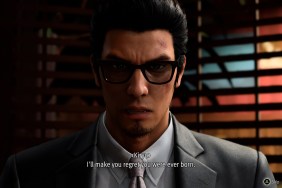Take the red mushroom pill.
Where do you go when you have explored the ends of the earth, the far reaches of the galaxy, the Nether World, the cross-dimensional timeline, the glory of Heaven, and the bowels of Hell? Well, inside, of course. Or in this case, the body of Mr. King Koopa, the one and only, Bowser.
[image1]Mario & Luigi: Bowser’s Inside Story starts like any other day in Mushroom Kingdom. Mario and Luigi eat some mushrooms, Princess Peach bakes a cake, and Bowser concocts another brash scheme to steal the princess. But then an incurable plague begins sweeping throughout Toad Town, turning its residents into hefty, plump, obese big-boned "blorbs". Princess Peach convenes an emergency town meeting at her castle, inviting the Mario brothers but reasonably not Bowser. Of course, that angers His Grouchiness and he barges into the meeting, gets his ass (shell?) handed to him, and finds himself in a forest. There, he gets tricked by Fawful, the main baddie in this adventure, who makes him eat a mysterious mushroom that turns his mouth into a giant vacuum, which as you might expect, is how Mario and Luigi get inside his story body.
Fawful’s plot is soon revealed, but it’s too late. Fawful, who speaks in intentionally irritating Engrish verb forms like “I have chortles!” and “I am hating you!” (as an editor, I want to strangle him), seizes Bowser’s castle in his attempt to conquer Mushroom Kingdom. Not surprisingly, that doesn’t sit well with Bowser and the Mario Brothers who both must work together to defeat this new evil, but similar to the plot of Super Mario RPG: The Legend of the Seven Stars for the SNES, their alliance is only temporary; in fact, Bowser is completely oblivious.
With the aid of the Star Sprite Starlow, Mario and Luigi must find their way out of Bowser’s various viscera, but not before realizing that they can control His Burliness if he’s ever in trouble. Sort of like “I scratch your back, you scratch my intestines”. Unbeknownst to Bowser, he thinks that Chippy (Starlow), not Mario and Luigi, is the one helping him.
Fortunately, these unusual circumstances are a springboard for absurdity and tongue-in-cheek, sexually awkward situations. Not only will Mario and Luigi talk in Peter Griffin Italian and massage Bowser’s arm muscles in a rhythm-based mini-game, but they also have to enter Bowser’s rump and activate his adrenaline, which revives Bowser and turns him into a Godzilla-sized Koopa. That’s right, giving Bowser some butt action from two Italian plumbers makes him feel like a giant. Delizioso.
[image2]While Mario and Luigi eventually escape Bowser’s bowels and explore the world like Bowser does, the levels within Bowser re-imagine human reptilian biology and anatomy, transforming nerve endings into switches, body tissue into wiggly walls and platforms, Goombas into Goombules, and cells into talking globins who offer advice and challenges. They provide a quirky contrast to the more traditional environments – plains, forests, deserts, caves, and castles – spread throughout Mushroom Kingdom.
Matching the light-hearted humor is a light turn-based system coupled with light platforming elements – all done with smooth, cheerful animations – lending an air of whimsy that we expect from Nintendo. Mario and Luigi spend as much time jumping, block-hitting, talking, hammering, shopping, and dungeon-crawling (Bowser punches and breathes fire) as they do strategizing in battle. Most actions are rarely out of the ordinary – attack with a jump, attack with a hammer, use an item – though each special attack has a unique spin, whether it’s memory, visual focus, or stylus skills. There’s even a challenge mode that rewards you special items depending on how long you can keep a special attack going.
If you’ve played most any RPG in the past, Mario and Luigi will be a breeze. This doesn’t mean it lacks depth or interest, but the pressure of dying is hardly ever felt. Though you will understandably stockpile on healing mushrooms (drumsticks for Bowser) in the introductory levels, the generous amount of healing items continues until the finale, when you’ll have enough mushrooms, syrups, nuts, and Star Candies to open your own convenience store in Toad Town. Moreover, Mario and Luigi have badges that can boost their attack, multiply any earned experience or coins, and even heal their wounds.
Similar to other RPGs in the Mario franchise, the action-based counterattack system adds a fresh take to the general gamut of RPGs by allowing you to escape from harm if your timing is precise enough. Nearly every enemy attack can be repelled or nullified, unless it’s a boss, who usually doesn’t give you a chance at a riposte whatsoever. Still, you will usually leave battles without a scratch once you learn an enemy’s patterns, and even if you miss, you have a whole warehouse of food to stuff yourself with health.
[image3]The other gripe is that the mini-games suffer the same symptoms of Final Fantasy X-2 syndrome. Though it’s innovative to see Giga-Bowser breathe fire upon giant robot castles (blowing into the DS microphone can be frustrating), and Mario and Luigi whack around some pollen, take some globin quizzes, massage arm muscles, and shoot balls of light down a river like in a schmup, they are all one-shot, gimmicky distractions. It’s sort of like a backseat gamer trying to get your attention: three interruptions and it’s okay, but twenty and it’s going to be a “slam face on table until it shuts up” situation. The mini-games do flesh out the concept of controlling Bowser’s body through Mario and Luigi’s actions, but at least four of them should have been edited out for brevity.
Mario & Luigi: Bowser’s Inside Story serves as an appealing introduction for beginners as a gateway to the RPG genre. More experienced players will wish there were fewer diversions and a harder difficulty setting in addition to the challenge mode, but Nintendo’s hallmark for ingenuity, imagination, and polish shines through. Squishing around in Bowser’s guts may not be the most pleasant thought, but it is a merry adventure that can be completed without a guide and is courageously and cleverly inspired.
-
Daring and successful concept
-
Whimsical story and dialogue
-
Polished animations and environments
-
Light-hearted humor
-
Too easy and straightforward
-
Too many forced mini-games











